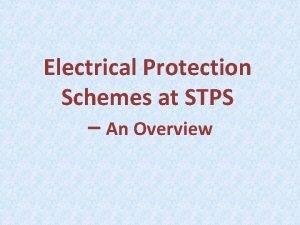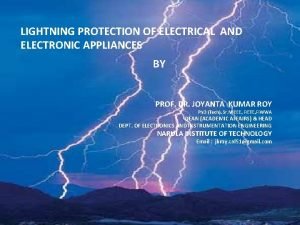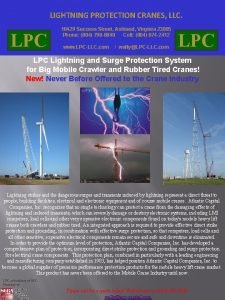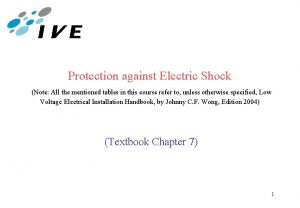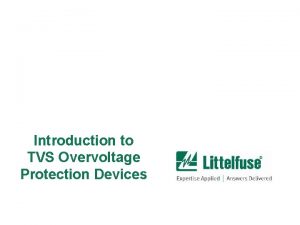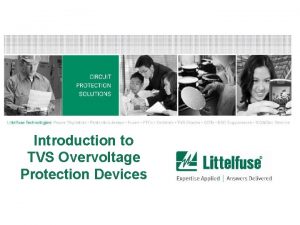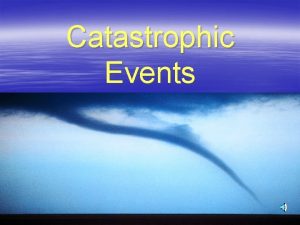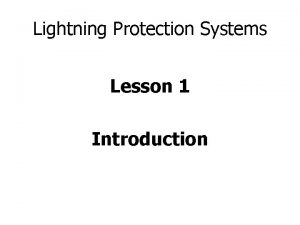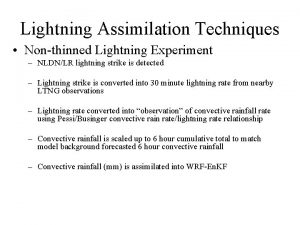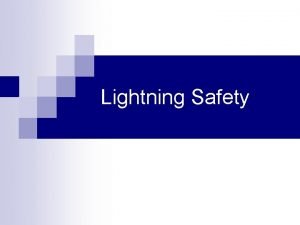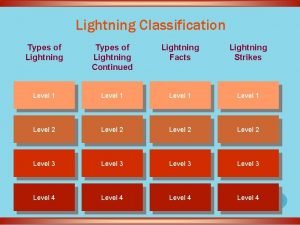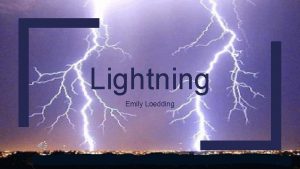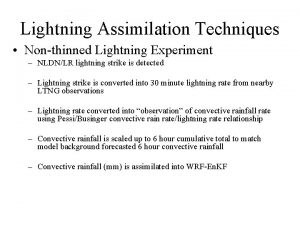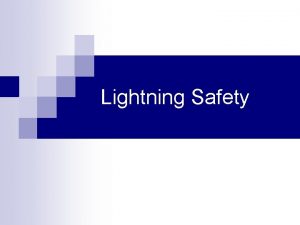AntennaEquipment Protection against catastrophic overvoltage Lightning Solar storm











- Slides: 11

Antenna/Equipment Protection against catastrophic over-voltage Lightning Solar storm Nuclear EMP Laird Taylor N 7 RSR – 25 Jun 2012

Executive Summary • Current (through your body) is what kills you – But voltage is what pushes current through you – Find a way to keep you & equipment @ same voltage • Sharpness (small radius) – Lightning easily enters/departs @edges & points – Lightning reluctantly goes around sharp corners • Ground conductors – 1 st instant, lightning travels only on surface – Foil & straps have more surface per cross-section area than do thick round wires, so ounce-for-ounce, they work better as low-impedance conductors

Historical Analogy: the Wheatstone Bridge antenna shack

3 cases of balanced bridge • Canonical 1000 1 1 laboratory 2000 safety-oriented 0. 1 outside 0. 001 (you) 1 1 3000 6000 100 inside 1

Links/URLs to design effort • The ARRL has much of this in public domain – Lightning protection for the amateur radio station (1. . 3) • http: //www. arrl. org/files/file/Technology/tis/info/pdf/0206056. pdf • http: //www. arrl. org/files/file/Technology/tis/info/pdf/0207048. pdf • http: //www. arrl. org/files/file/Technology/tis/info/pdf/0208053. pdf – Lab notes – lightning protection (1. . 2) • http: //www. arrl. org/files/file/Technology/tis/info/pdf/109481. pdf • http: //www. arrl. org/files/file/Technology/tis/info/pdf/129445. pdf – Electromagnetic pulse and the radio amateur (1. . 4) • • http: //www. arrl. org/files/file/Technology/tis/info/pdf/88615. pdf http: //www. arrl. org/files/file/Technology/tis/info/pdf/98622. pdf http: //www. arrl. org/files/file/Technology/tis/info/pdf/108638. pdf http: //www. arrl. org/files/file/Technology/tis/info/pdf/118630. pdf

Know the enemy: Lightning context of a C-G stroke • Earth has a near-uniform vertical electric field – ~350 V/meter – Earth is negative – sky is positive • A Thunderstorm is a giant static-electric machine – The “shadow” of a T-storm may have ~10 k. V/meter field – This isn’t enough (by ~10: 1) to electrically break down air – Russian scientists theorize: ion tracks from solar particles “help” build a localized conductive bridge for the stroke

Know the enemy: Lightning Parameters of a stroke • Peak current – Average: 18 k. A - 98% of strokes are in range 10. . 50 • Duration – Average: 5 msec - 98% of strokes are in range 2. . 10 • Number of flashes/stroke – Average: 4 – 98% of strokes are in range 1. . 11 • Time interval between flashes – Average: 20 msec – 98% of strokes are in range [ ]

Know the Enemy: Lightning Daily probability you’ll hear thunder during day • Varies greatly across America – There’s a national map from the US Government – Ft Worth/Denton are at the ~50 days/yr contour, averaged over decades. • This year is wet, last year was a 100 -year drought

January 2009 Utah County ARES Training Item • A "Window" in the world of radio is a way to bring our antenna cables into our building such that the best lightning protection is offered. • • Lightning destroys our radios, power supplies and computers when it finds its way through our equipment. The high current from a direct strike will cause damage, even melting and fusing metal in our towers and cables. – We can't do much to protect our exposed gear against a direct strike, but – we can mitigate the path of those hyperactive electrons when they come near. The idea is to direct them to the earth, or "ground", as soon as possible and keep them from flowing into our equipment, where even a little current or spike of voltage can destroy sensitive transistors and integrated circuits. • A Window is the location where the cables enter into our structure. It is at this Window, or point of entry, where we want to put our lightning arrestors and protection devices. A key feature for a good lightning protection scheme is to have a single electrical "Window" into the building. The idea is to keep all of these electrical services at the same electrical potential. If there is a differing potential, or voltage, then there are currents flowing through conductors. Those damaging currents can take an unexpected path.

1 st example – before the strike a copper pipe J-pole antenna on the peak of my house • I run the cable through the vent in the gable, through the attic and then down through spaces in the wall into my radio room in the basement. Here I hook the antenna to the radio. • The radio is also directly connected to a power supply that connects to the mains power of my home. I ensure that all of my equipment is grounded to the three prong electrical outlet. I also have my rig hooked up to my computer for digital modes. The computer has connections to the telephone and a home network. • Now lightning strikes; it doesn't have to be a direct strike to the J-pole, it may be a block away. The electrical field will be picked up by the antenna (that's what antennas do, right? ) and send current down through the coax, through the radio and to ground through the power supply and computer. • Much of this current stays on the ground wires, but since there is resistance (and inductance) in every wire, there is voltage directed into our electronic circuits; it may be direct or it may be induced. The likely outcome is a dead – – Radio power supply Computer internet gateway and more. OUCH.

2 nd example – after the strike I have just bought a new rig and computer (ergo, I survived) • Now I decide to make some changes. – This time I route the coax from my antenna down the back of my house to the location where the power meter is. This is the same place where the telephone company brings in their lines. – Here [there] is a ground rod that protects both the electrical service and telephone entry. This is where I place my new lightning protection device and tie it to ground with a flat braid or heavy solid copper wire (4" wide copper works best). The coax now enters through the same "Window" as the mains power and the telephone. – I minimize the length from the grounds to each of these services to the ground rod so that they have a "single point ground" that maintains the same potential. – If done right, when that next inevitable lightning strike happens, the path to ground is NOT into my home and through my equipment. There will be a potential on the cables entering through this common Window relative to the earth but there will not be a potential, or it will be small, between the electrical system and my radio gear. Thus the currents will be at a minimum and the potential for damage is minimized. The voltage on all paths to the equipment will rise and fall together. • Hint: I may also consider taking the coax underground and bringing it up at the Window I created. It is also good to enhance the ground add grounds as described in the articles below.
 Low forward power protection
Low forward power protection Catastrophic risk protection endorsement
Catastrophic risk protection endorsement Switching overvoltages in ehv and uhv systems
Switching overvoltages in ehv and uhv systems Iec 62305-2
Iec 62305-2 Crane lightning protection
Crane lightning protection United lightning protection association
United lightning protection association Catastrophic epilepsy infancy
Catastrophic epilepsy infancy Fallacy of catastrophic expectations
Fallacy of catastrophic expectations Catastrophic event
Catastrophic event What are some types of catastrophic events
What are some types of catastrophic events Which microorganism
Which microorganism Eebads definition
Eebads definition
